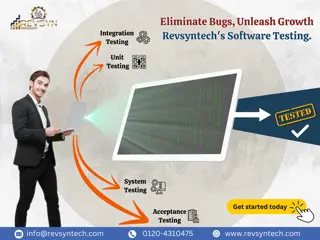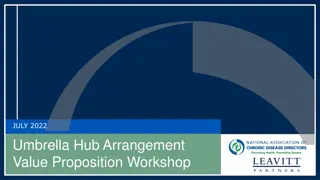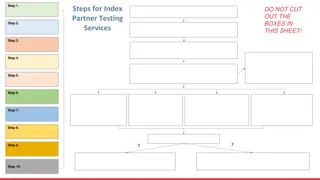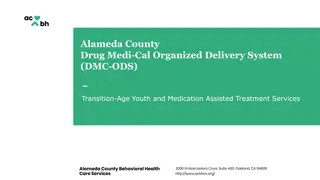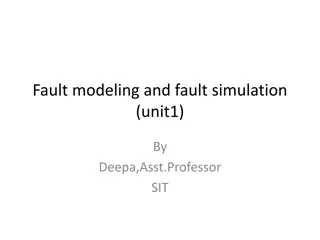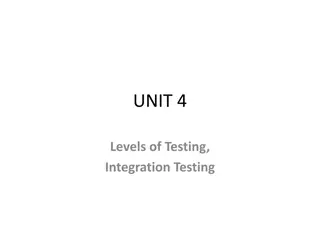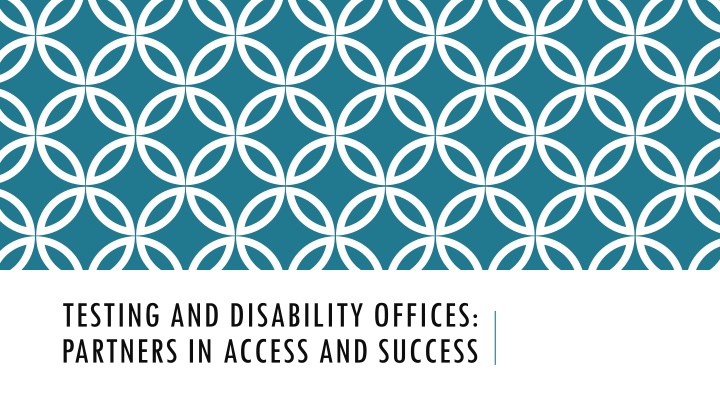
Effective Collaboration in Testing and Disability Offices
Discover how testing and disability offices can successfully collaborate to enhance accessibility and support for students with disabilities. Learn about models for accommodative testing and the importance of collaboration in addressing the diverse needs of students nationwide.
Download Presentation

Please find below an Image/Link to download the presentation.
The content on the website is provided AS IS for your information and personal use only. It may not be sold, licensed, or shared on other websites without obtaining consent from the author. If you encounter any issues during the download, it is possible that the publisher has removed the file from their server.
You are allowed to download the files provided on this website for personal or commercial use, subject to the condition that they are used lawfully. All files are the property of their respective owners.
The content on the website is provided AS IS for your information and personal use only. It may not be sold, licensed, or shared on other websites without obtaining consent from the author.
E N D
Presentation Transcript
TESTING AND DISABILITY OFFICES: PARTNERS IN ACCESS AND SUCCESS
INTRODUCTIONS Sara Rieder Bennett, Ph.D. Assistant Director of Testing and Licensed Psychologist, Counseling & Testing Center, The University of Akron President, Ohio College Testing Association Kelly Kulick, M.Ed., CRC Director of the Office of Accessibility, The University of Akron Jessica DeFago, M.A. Associate Director of the Office of Accessibility, The University of Akron Heather Vennekotter, LLPC, MRC Testing Center and Accommodative Services Coordinator, Rhodes State University Jennifer Radt, MSW, LSW Sr. Director of Student Affairs and Director of Disability Services, UC Clermont
GOALS FOR PRESENTATION Provide overview of three campuses approaches to accommodative testing Define collaboration and identify barriers and supports to effective collaboration Present lessons learned for successful collaboration between our offices Panel question and answer, and group discussion
BACKGROUND ON ACCOMMODATED TESTING Increasing prevalence, diversity, and needs of students with disabilities nationwide ADA Amendments Act Decreased or stagnant institutional resources Need for collaboration between service-provision offices The University of Akron model six years of collaborative testing between OA and CTC Rhodes In 2012, the Testing Center and Accommodative Services Departments were combined to assure that Accommodative Services is available to address any testing concerns. UC Clermont
OA increase in active students 36.9% 2.5% 13.4% 4.8% 21.7% 8.7% -3.2% 14.0% 13.4% 10.8% 10.0% 9.5% 15.8% UA increase in Fall enrollment 5.3% 0.8% -0.7% -3.7% 4.0% 5.0% 5.0% 7.6% 4.8% 1.5% -3.1% -5.9% -4.5% Year UPWARD TREND IN ACCESSIBILITY NEEDS (DATA FROM UA) 2002 2003 2004 2005 2006 2007 2008 2009 2010 2011 2012 2013 2014
CTC ACCOMMODATED TESTING FROM THE BEGINNING Year to Date 800 749 700 2009 2010 2011 2012 2013 2014 2015 600 470 500 385 400 299 300 238 200 100 4 0 0 2009 2010 2011 2012 2013 2014 2015 -100
MODELS FOR ACCOMMODATED TESTING Instructor Delivery + Content experts in exam, familiarity with student - Often not trained in testing or disability, lack appropriate testing space, accommodated exam delivery may be perceived as outside their job/impinging on time and resources Disability Service Office Delivery + Awareness of disability laws & policies, student needs, familiarity with student - Often not trained in test proctoring or set up to have appropriate testing space, may have conflict of interest due to advocacy roles for students, lack content knowledge of exam Test Center Delivery + Experts in testing, have appropriate test space, existing procedures and policies to manage testing, assumption that lack conflict of interest - Often not trained in disability and accessibility issues, lack content knowledge of exam
UA SIX YEARS LATER Testing accommodations determined with documentation and intake at OA Extended time: specific amount depends on impact of disability, determined by Disability Specialist Distraction reduced space no guarantee of private/distraction free space Test proctors for reading/scribing Use of technology computers, CCTV, adaptive software, etc. Students not to use personal devices for testing. Cases assigned based on accommodation need and how proctors function in each setting: OA individualized accommodation based on need of student. CTC proctors monitor testing environment for students with disabilities, distraction reduced environment, extended time, access to materials such as computer/calculator Students maintain option to take tests with class without accommodations; with accommodations provided by instructor; at CTC or OA as assigned; or at Computer Based Assessment & Evaluation if required of the course (i.e. Springboard exam).
Barriers and Supports Centrality to Effective Services Necessary Conditions COLLABORATION
LITERATURE ON COLLABORATION Relationships are the currency of partnerships (Colucci et al., 2002, p., 218) AHEAD defines as: people with common concerns and needs put their heads together to arrive at a mutual solution Collaborations often fail why? They require: layers of administrative oversight; creation of new policies; commitment of resources/staff time; recognition that the partnership creates a win-win situation; good past relationships, goals, and communication Barriers are prevalent: turfism; lack of ownership by stakeholders; lack of power in decision-making; unfavorable attitudes about collaboration Melaville & Blank (1991) Five Principles of Collaboration: Partnership between diverse stakeholder leads to more comprehensive identification of issues and solutions Establish common goals to guide activities Jointly plan, implement, and evaluate services by whole group Commit resources to achieve mutually identified vision for services Delegate individual responsibilities to group members to full goal of whole group
NECESSARY CONDITIONS 1. Open and non-defensive communication and inclusion of stakeholders in iterative decision- making process 5. Collective philosophy and mission 6. Maintaining a flexible learning orientation 7. Restructuring to allow shared leadership and resources 2. Adopting same procedures and models 8. Building one another as team 3. Collaborating on outreach and education of campus 4. Recognition and promotion of one another s expertise
REFERENCES ASHE. (2010), Partnerships and Collaborations. In ASHE Higher Education Report, 36, 1 15. doi: 10.1002/aehe.3602. Association on Higher Education and Disability. (1996). Using collaboration to enhance service for college students with learning disabilities. Journal on Postsecondary Education and Disability, 12. http://www.ahead.org/publications/jped/vol_12 Colucci, K.L., Epanchin, B.C., & Laframboise, K.L. (2002). Collaborative professional development partnerships. In J.L. Paul, C.D. Lavely, A. Cranston-Gingras, and E.L. Taylor (Eds.) Rethinking Professional Issues in Special Education. P 209-229. Ablex Publishing: Westport, CT. 1-56750-626-7 ISBN. Harbour, W.S. (2009). The relationship between institutional unit and administrative features of disability services offices in higher education. Journal of Postsecondary Education and Disability, 21, 138-154. Horgan, T.R., & Scire, D. (2007). Enhancing access and building a campus culture of civic engagement and service-learning: A dual consortia approach. New Directions for Higher Education, 138, 83-94. Melaville, A., & Blank, M. (1991). What it takes. structuring interagency partnerships to connect children and families with comprehensive services. Washington, D.C.: Education and Human Services Consortium. O Connor, T., Pettyjohn, H., & Duffy, T. (August 2013) NCTA National Conference Presentation. Accommodated Testing: Furthering the Discussion.

